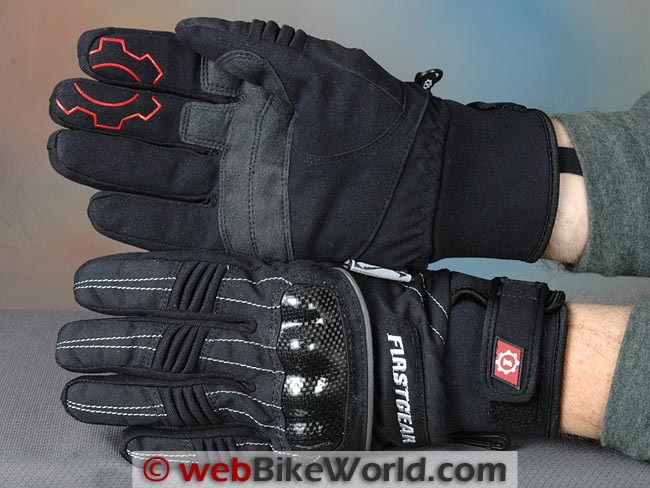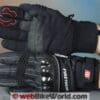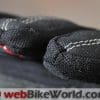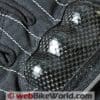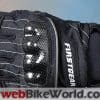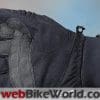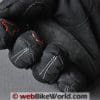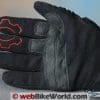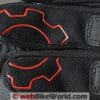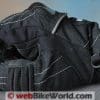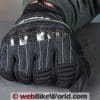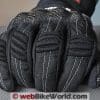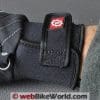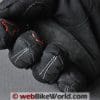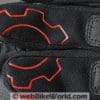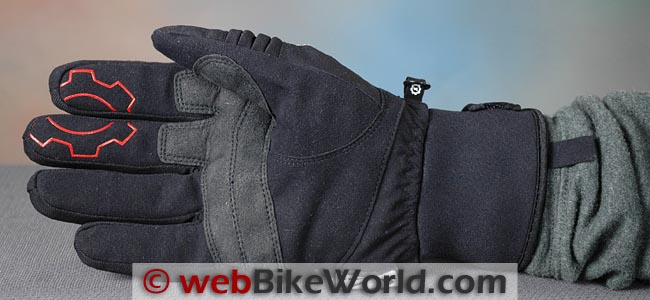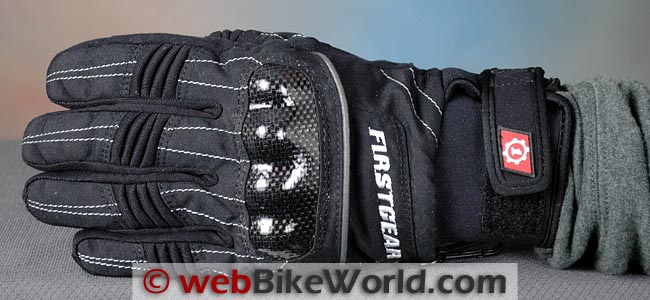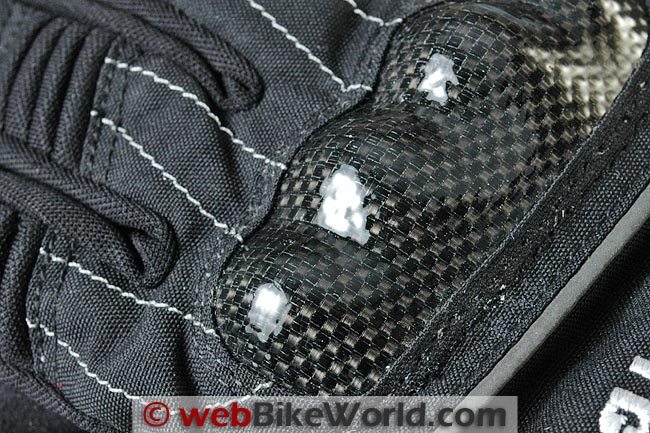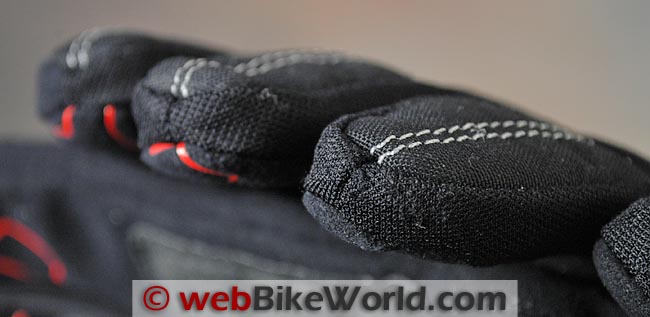Let’s just put it this way: the Firstgear Kathmandu gloves did not live up to my expectations.
As I mentioned in Part 1 of this 2011 Winter Glove Review series, the Firstgear Kathmandu gloves and the Spidi T-Winter gloves (review) were specifically chosen for a couple of reasons.
Spidi products are under-represented in webBikeWorld reviews and their “H2Out” line of waterproof clothing is popular with motorcycle riders around the world, so it was time to take a look at a new Spidi glove for 2012.
Firstgear is also a very popular brand and the Firstgear Kathmandu glove seemed like a rough equivalent of the Spidi T-Winter gloves.
Also, both of these gloves are apparently designed to wear under a motorcycle jacket sleeve, not over.
While the gauntlet on the Spidi T-Winter gloves is somewhat of a compromise in terms of its size, there’s really no other way to wear the tight-fitting gauntlet on the Kathmandu gloves other than under a jacket sleeve.
Both gloves have a list price of around $90.00, which isn’t exactly a bargain.
Unfortunately, the Spidi gloves don’t really perform as well as we’d like and the Firstgear Kathmandu gloves…well, they need a complete re-think.
Firstgear Kathmandu Gloves – Introduction
The Kathmandu gloves appear to have good technical specifications, based on the Firstgear marketing info.
For example, although Firstgear doesn’t specifically call these “winter” gloves, it does say that the gloves have 40 grams of Thinsulate insulation “for warmth” and a “Neoprene cuff to lock out cold air”.
The Kathmandu gloves are also listed on the page with other Firstgear textile winter gloves, such as the Kilimanjaro, Explorer and Master gloves.
By the way, it seems that the Kilimanjaro name is used for the top-of-the-line Firstgear clothing, while the Kathmandu name is used for the runner-up or second level gear with a slightly lower list price.
Firstgear advertises “40 grams of Thinsulate” in the Kathmandu gloves, so these are for winter. Riding in temperatures down to about 40 F (4 C) and switching back and forth between the Spidi T-Winter gloves and the Firstgear Kathmandu gloves, I could definitely tell the difference.
It feels like there’s a lot more air flowing into the Kathmandu gloves…and it probably is.
The outer material just doesn’t seem to offer as much wind-blocking as the tighter fabrics used on the Spidi gloves.
So despite the Thinsulate, the air quickly surrounds the membrane and my hands get chilled. I’d say the Kathmandu gloves are good down to temperatures only as low as perhaps 47 to 50 F (8-10 C).
Surely the most noticeable feature difference between the Spidi T-Winter gloves and the Kathmandu gloves is the tight-fitting neoprene gauntlet or cuff.
These gloves are quite different from most or all of the other winter (or summer) gloves reviewed on webBikeWorld. The gauntlet is designed to be very tight fitting, surrounding the wrist to (I guess) keep out cold air and moisture.
This means that the gloves can only be worn inside a sleeve cuff, which has advantages and disadvantages, as I noted in the Spidi T-Winter glove review.
But while the T-Winter gloves can at least fit over some thinner types of sleeve cuffs, the Kathmandu gloves can not, so you have to be really sure you want to wear your gloves under the sleeve before you buy a pair.
Firstgear Kathmandu Glove Details
The Kathmandu gloves also have a (claimed) waterproof and breathable “Hipora” membrane and 330 denier Cordura on the upper part of the gloves.
Clarino synthetic leather is used in a section that runs from the thumb across the inside of the palms.
Unfortunately, the choice of materials gives the gloves a slightly cheap feel; it may be the Clarino synthetic material, combined with the cut of the gloves across the palm, which is a bit bulky.
Also, the sizing of this pair seems off; they are a size large but feel closer to a size medium.
The fingers are short and the seams in the fingertips interfere with my fingernails.
The body of the gloves isn’t tailored very accurately, and combined with the faux-feel Clarino, it makes the gloves bunch up or feel bulky across the palm, rather than form-fitting.
So overall, the Firstgear Kathmandu gloves present a paradox.
Although the overall construction appears to be good, with aligned stitching and no obvious loose threads or errors, the basic choice of materials, the inexpensive-feeling liner, the slight undersize of the glove body but excess bulk across the palm and the cheap-looking carbon fiber main knuckle protector all seem a grade or two lower than I’d prefer.
One other strange feature of these gloves is the “magnetic” dirt-collecting ability of the fabrics used throughout, which seem to attract any and every bit of dust, hair and other detritus.
The gloves instantly started looking dirty as soon as they were unpacked and they continue to attract dirt at a pretty amazing rate.
I suppose this shouldn’t matter much for a pair of outdoor gloves but I find myself constantly shaking them to try and remove the bits of fuzz that seem to collect on them and it’s just one more feature that gives the gloves a low-rent feel.
It’s nice to find a product where the list price seems lower than expected for what you get, but in this case, the price seems at least 25% higher than what is actually delivered.
90 bucks is 90 bucks — real money in my book, and I expected more. Of course, that’s all opinion, but that’s the way I see it.
Gauntlets
As I mentioned above, the Firstgear Kathmandu glove gauntlets are of a different design than most or all of the full-gauntlet type winter gloves previously reviewed on webBikeWorld.
These are tight-fitting gauntlets or cuffs, made from neoprene. They are slightly stretchy and they are designed to basically seal the glove around the wrist.
They are relatively comfortable and they do help to seal out cold air and some moisture from entering the glove, with a single, narrow hook-and-loop tab over the top of the gauntlet.
Neither the Kathmandu gloves nor the Spidi T-Winter gloves have have a secondary wrist strap, which means they can be pulled off the hands even when they’re secured by the single wrist closure.
This is a potential safety issue, because you want to make sure the gloves stay on your hands when they’re needed most — during an accident.
In a bit of an irony, the tight fit of the close-fitting gauntlets do help to keep the Kathmandu gloves on the hands more securely than the Spidi T-Winter gloves, but although they’re more difficult to pull off, it can be done, so a secondary strap is really needed here also.
The gauntlets fit under all of the sleeve cuffs of various winter jackets we tried, which some motorcyclists prefer. Just be aware that there really isn’t any other option with the Kathmandu gloves.
Waterproofing
Firstgear claims that the Kathmandu gloves are “Waterproof and breathable”, through the inclusion of a Hipora membrane.
Unfortunately, our pair started to leak in the “bucket test”, where we put on the glove and place the hand in a bucket of cold water.
I started the timer, dunked my hands in the water and I immediately felt the water penetrate through the outer layers of fabric, which apparently have no water-resisting capabilities at all.
The water then started to leak through into the gloves at the base of my fingers. I looked at the timer: 10 seconds.
The outer fabric also seems very resistant to drying; at the time I’m writing this, the gloves have been sitting on a wooden drying rod, straight up, inside the house and they’re still damp to the touch after about 42 hours.
Evaluating a single item, whether it’s a glove, boot, jacket, helmet or anything else, obviously makes it difficult to project a result over an entire product line or brand for the entire production run.
But I can only report on our results, and this pair of Kathmandu gloves failed the waterproof test in fairly dramatic fashion.
Stitching and Armor
The overall construction of the Kathmandu gloves is generally good, but I think the product is let down by the design, to be frank.
The fabric that was chosen for the top of the gloves just seems to be too loosely woven for a winter glove.
This fabric is also used on the sides of the fingers and the fabric covering the fingertips started to fray nearly as soon as I started wearing the gloves.
The white- or silver-colored stitching down the backs of the fingers appears to be for style purposes only, but I think it gives the gloves an inexpensive look, so it could have been eliminated.
Because the stitches are wide, they are exposed in a way that makes me thin thread will pull or fray also.
Like the Spidi T-Winter gloves, the Kathmandu gloves have only a main knuckle protector.
It’s a carbon fiber piece and it’s suitable for the job, but as long as I’m piling on, I may as well also admit that Firstgear coated it with a too-shiny clear coat.
Yet it’s not a very smooth finish, because the “bumps” and irregularities from the carbon fiber cloth can be felt. It’s almost like not enough effort was put into sanding it smooth before applying the clear coat.
There is no other hard armor protection on the gloves, but the same can be said for the Spidi T-Winter gloves.
Compare that to the British Motorcycle Gear Thermosport gloves (review) — just take a look at the difference in protection and I think you’ll see (and the BMG gloves cost $10.00 less).
Note that I am not saying the BMG gloves are the ultimate winter gloves, but they certainly compare much better I think in the price range we’re talking about here for the Spidi T-Winter and Firstgear Kathmandu gloves of $80.00 to $90.00.
The Kathmandu gloves have flexible accordion pleats over the middle knuckles of each finger, but no added protective features either on the fingertips or on the side of the hand.
Fit and Ventilation Comfort
AAlso like the T-Winter gloves, the Kathmandu gloves have no ventilation or perforations, although the fabric and membrane does seem to breathe — a bit too much so, as I mentioned.
The Kathmandu gloves unfortunately just don’t feel as comfortable as the Spidi T-winter gloves.
In fact, the Spidi gloves feel about two or three notches higher in terms of quality, with a more comfortable and smoother interior; a better fit that is closer to expected sizing; and an overall higher-quality fit, finish and ambience.
Plus, the Spidi T-Winter gloves passed the “bucket test” with flying colors…although neither of these would be my first choice if I had 80 bucks to spend on winter gloves.
The use of the synthetic Clarino leather and the bulkier-than-average fit across the palm of the Kathmandu gloves also doesn’t help when it comes to comfort.
Conclusion
I feel pretty bad, honestly, because I suppose it’s not fun to review a product that doesn’t live up to expectations. I had no idea what these gloves were like before they arrived for me to review.
I had never heard of them before and I went into it with an open mind, but honestly, all I can say is that there are probably better mild-winter motorcycle gloves available at this price range.
Sorry, Firstgear — let us know when/if they are improved and we’ll be happy to run them through once more!
Owner Comments and Feedback
See details on submitting comments.


